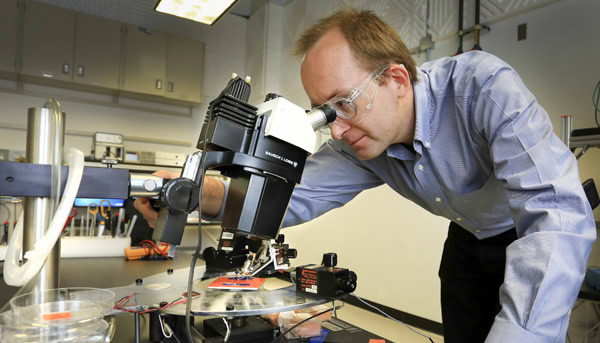
[Image credit] The Institute for Functional Imaging of Materials is set to accelerate the discovery, design, and deployment of new materials. Pictured above is IFIM’s inaugural director Sergei Kalinin. Credit: Jason Richards; ORNL
Materials research for the win: Oak Ridge National Laboratory recently announced the launch of the Institute for Functional Imaging of Materials (IFIM).
According to an ORNL release, the institute—which will unite experts in imaging instrumentation, fundamentals in physical and chemical imaging processes, and data analytics—will accelerate the “discovery, design, and deployment of new materials.”
It also will further President Obama’s materials call-to-arms—the Materials Genome Initiative (MGI). The White House reports that since its launch in 2011, MGI has invested more than $250 million in new R&D and innovation infrastructure, which now includes IFIM.
“Advanced materials are essential to clean energy, national security and global competitiveness,” says ORNL director Thom Mason in the press release. “Key energy technologies like solar cells, superconductors and batteries all have shortcomings that next-generation materials might overcome.”
“Advances in imaging over two decades make it possible to observe and identify individual atoms in materials, but knowing the position and chemical identity of the atoms is not sufficient to understand how these atoms function in a material,” says Sergei Kalinin, IFIM’s inaugural director. “Advances in imaging are now catalyzing a major transition in this field—making it possible to determine not only where things are, but what things do.
By marrying data with demonstration, the institute will allow scientists to better capture and analyze the avalanche of data that results from exploring a material through imaging tools.
“Through computing tools we’ll be able to quickly find the needle in a haystack of big data—think Google for materials,” says Kalinin. “Today our imaging studies generate much more data than we can possibly process, and we’re throwing most of it away. Real-time data analytics will allow us to build a bridge between materials theory and function.”
Housing the institute at ORNL seems like a natural fit, given the imaging capabilities at the lab’s Center for Nanophase Materials Science, and its Chemical Sciences and Materials Science and Technology Divisions. ORNL anticipates the expertise will “improve the efficiency of such tasks as converting solar energy to electricity (in solar cells), transporting energy to the grid (superconducting cables), or converting chemical to electrical energy (batteries).”
For more information on the imaging institute, click here.
Author
Jessica McMathis
CTT Categories
- Electronics
- Energy
- Material Innovations
- Weekly Column: “Other materials”

